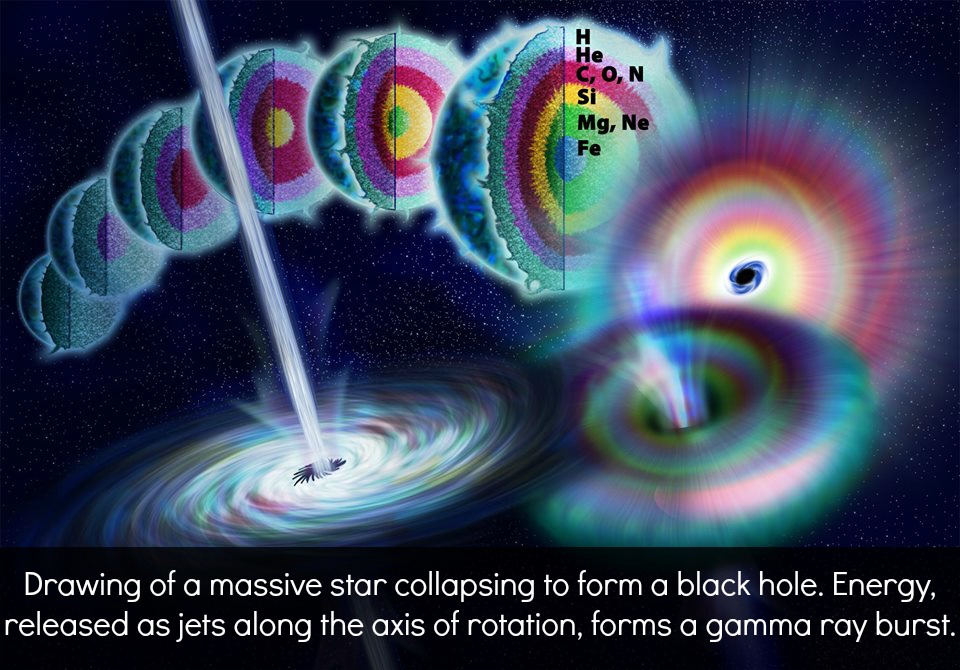

Gamma-ray bursts (GRBs) are flashes of gamma rays (electromagnetic radiation of high frequency) that come from energetic explosions in distant galaxies. They are known to be the most radiating electromagnetic events in the Universe. The bursts can last from ten milliseconds to several minutes (a typical burst lasts 20-40 seconds). GRBs were discovered in the lats 1960s; however, this was not an intentional discovery. They were discovered by the U.S. Vela satellites that were actually built to detect gamma radiation pulses emitted by nuclear weapons tested in Space. Why? Well, the USA suspected that the USSR might attempt to conduct secret nuclear tests after signing the Nuclear Test Ban Treaty in 1963.
The very first gamma-ray detector sent into space was the Explorer XI satellite. It was launched in 1961, and it ran for 7 months. In all of this time, only 6 days (141 hours) of observation was usable. Explorer XI detected gamma-rays with energies of 100 MeV and above. At this point in time, the scientific community wasn’t expecting to see any GRBs. The original 1965 paper mentions several different expected mechanisms for the gamma-rays that were being detected by the Explorer XI satellite, mechanisms ranging from pion decay to cosmic rays interacting with electrons — there is no mention (not even a hint) of gamma-ray bursts.
The first detection of GRBs came from the Vela satellites ,which were owned by several branches of the United State government. Their purpose was to detect gamma-ray sources primarily on the Earth’s surface, and in the atmosphere, in order to make sure that other countries weren’t breaking international treaties with their use of nuclear weapons. In total, only 16 events were deemed to be of cosmic origin [not from the Earth or the Sun]. These observed events had a range of time from less than 0.1 second all the way to 30 seconds. The energies that the Vela satellites detected were between 0.2-1.5 MeV (which is lower than the GRB detection threshold of several of the succeeding satellites).
Though the first GRBs were detected in the 1960s, it would be another 30 years before the detection of GRBs would come to the forefront of science, with the launch of the Compton Gamma-Ray Observatory [CGRO]. Within those 30 years, several telescopes had been launched into space to detect and map the gamma-ray sky; however, none of them were looking into GRBs until CGRO. When the CGRO was launched in April of 1991, it was the largest [heaviest] observatory launched into space — weighing in at nearly 17,000 kg (37,000 lbs). It was the second of the great observatories to be launched into space (the first was the Hubble Space Telescope).
When CGRO was launched in 1991, it consisted of four different instruments:
Orientated Scinillation-Spectrometer Experiment [OSSE]
Burst and Transient Source Experiment [BATSE]
Compton Telescope [COMPTEL]
Energetic Gamma-ray Experiment Telescope [EGRET]
The main piece of equipment for the detection of these bursts was BATSE. BATSE was incorporated into CGRO for the specific purpose of detecting GRBs, it consisted of eight modules scattered around the craft to obtain a full view of the universe (in all directions). Each module consisted of two types of detectors: Large Area Detector [LAD] and the Spectroscopy Detector [SD]. LAD consisted of a 2025 cm^2 flat NaI[T1] crystal set and was sensitive to the 20-2000 keV band, but it was usually triggered by energies within 50-300 keV. BATSE would be triggered when two or more LADs detected a source, this means that the overall sensitivity of BATSE to GRBs was dependent on at least the second illuminated LAD.
Over the years that CGRO was in action, it detected over 2000 GRBs. By 1998 the BATSE catalog contained 2,704 confirmed detections, which equates to about one GRB detection per day. The results from BATSE showed that the distribution of GRBs in the sky were isotropic. This tells us that GRBs aren’t localized to the Milky Way; they’re evenly distributed in all directions, not just the galactic plane. It can then be assumed that GRBs must come from all parts of the universe.